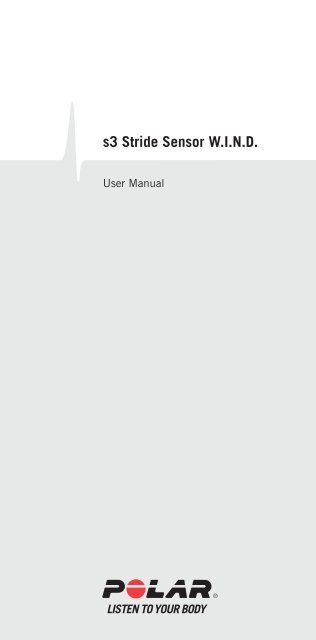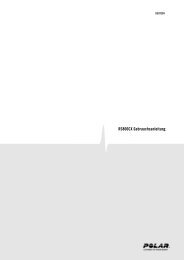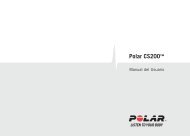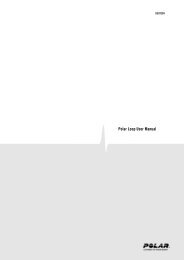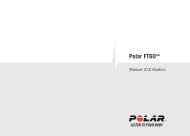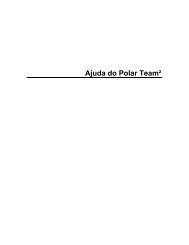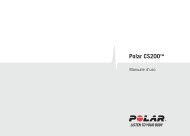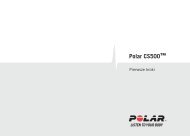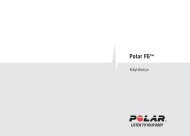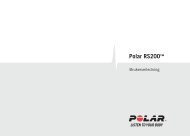Polar s3 Stride Sensor W.I.N.D. User Manual
Polar s3 Stride Sensor W.I.N.D. User Manual
Polar s3 Stride Sensor W.I.N.D. User Manual
You also want an ePaper? Increase the reach of your titles
YUMPU automatically turns print PDFs into web optimized ePapers that Google loves.
<strong>s3</strong> <strong>Stride</strong> <strong>Sensor</strong> W.I.N.D.<strong>User</strong> <strong>Manual</strong>
1.OPEN2.3.OPEN4.5.6.7.
Congratulations! The <strong>Polar</strong> <strong>s3</strong> stride sensor TMW.I.N.D. is the best choice for improving yourrunning technique and efficiency. Usingsensitive inertial sensors to track the position ofthe foot, it is immune from signal dropout, andgives accurate and highly responsive speed,distance, leg cadence and stride lengthmeasurements.The latest version of this user manual can bedownloaded at www.polar.fi/support.For video tutorials, go tohttp://www.polar.fi/en/support/video_tutorials.Please follow the pictures on the front cover.Install <strong>Stride</strong> <strong>Sensor</strong> BatteryENGLISHBefore using the <strong>s3</strong> stride sensor for the firsttime, insert the battery (included in the productpackage).1. Open the battery cover by turning itcounterclockwise to OPEN using the sensorfork or a coin (see picture 1).2. Place the battery inside the cover with thepositive (+) side facing the cover (seepicture 2). Make sure the sealing ring is inthe groove to ensure water resistance.3. Place the cover with the battery inside itinto the sensor.4. Press the cover in place and close it byturning clockwise from OPEN to CLOSEusing the sensor fork or a coin (see picture3). The <strong>s3</strong> stride sensor can be positionedeither on the shoelaces or in the sole cavityof a specific running shoe.1
ENGLISHTeach a New <strong>Stride</strong> <strong>Sensor</strong> to Your WristUnitYour new <strong>s3</strong> stride sensor must be introduced toyour <strong>Polar</strong> product in order to analyze yourrunning technique and efficiency. This is calledteaching. For further information, refer to theuser manual or go to www.polar.fi/support.Attach <strong>Stride</strong> <strong>Sensor</strong> on Shoelaces1. Undo the flap and detach the fork (seepicture 4).2. Loosen your shoelaces and place the forkunderneath them, on top of the tongue ofthe shoe (see picture 5).3. Tighten the laces.4. Fit the front part of the sensor onto the forkand press from the rear (see picture 6).Fasten the flap.5. Make sure the sensor does not move and isaligned with your foot. The more secure thesensor, the more accurately speed anddistance is measured.2
ENGLISHCalibrate the S3 <strong>Stride</strong> <strong>Sensor</strong>Optional calibration of the stride sensor canimprove the accuracy of speed, pace anddistance measurements. It is recommended thatyou calibrate the stride sensor before using itfor the first time, if there are significantchanges in your running style, or if the positionof the stride sensor on the shoe is dramaticallychanged (e.g. if you have new shoes). You cancalibrate the stride sensor by running a knowndistance, or by setting the calibration factormanually.Calibrate stride sensor during training(on-the-fly calibration): You can calibrate thestride sensor at any phase of your trainingsession with actual distance correction, whenyou have run a known distance, preferably morethan 1000 meters, calibrate the stride sensor asinstructed in the user manual for the <strong>Polar</strong>product in question.Set calibration factor manually: Thecalibration factor is calculated as a ratio of theactual distance to the uncalibrated distance.For instance if you run 1200 m and the <strong>Polar</strong>product shows a distance of 1180 m, thecalibration factor is 1.000. Calculate the newfactor as follows: 1.000*1200/1180 = 1.017.The measuring range for the factor is0.500-1.500.3
Meanwhile, Queensland about the same time was responding to the WiltshireReport, in which a provisional values charter for state schools was proposed andeducational authorities in several other states were trialing values frameworks fortheir systems.The Commonwealth Government too was ‘beginning to emerge from its neutraliststance when the so-called Civics Expert Group was set up’ with its 1994 reportconfirming ‘the priority of values education in the public sector’; though a change ofgovernment ‘somewhat delayed further developments at the Federal level’ for sometime. Then in mid-2002 the present Federal Government launched a ValuesEducation Study which was charged with the task of developing an agreedframework and encouraging better classroom practice, and this consultation is, ineffect, a progress report of this study. Its emphasis on action research is, Hill stated,‘to be applauded, and it’s also great to see boundaries being crossed: between states,and between the state and non-state sectors’.What are some pedagogic challenges?The current interest in experiments at the chalk-face is, Hill noted, ‘very timely’;albeit showing that values education is complex and controversial. He thencommented on a number of challenges coming to light in the reports of thoseexperiments.Describing the nature and sources of values‘I’m not sure’, he argued, ‘we yet know how to talk about values. The Final Report ofthe Values Education Study elected fairly summarily to adopt a definition byHalstead and Taylor which spoke of values as principles and standards that guidebehaviour. 1 This carries a cognitive weighting which potentially obscures themotivational aspect. How and why should propositions of thought be supposed tohave any real bearing on conduct? I sense that we’re still grappling with the problemof moving the student from “knowing the good to be desirable” to “desiring to do thegood.” 2 His own preferred definition in this context is that ‘values are “the prioritiesindividuals and societies attach to certain beliefs, experiences, and objects, in deciding howthey shall live and what they shall treasure”.’ This, he suggested, ‘shifts the focus from avalue being a merely cognitive state of mind to a whole-person decision, readiness or“disposition” to act in certain ways, given the opportunity’.Identifying the teaching domainsThis definition has significant implications for the way we view the teaching ofvalues. ‘First, it implies that there is a cognitive component, because value prioritiescan clearly be described in propositional terms, and are accessible to good reasonsbeing given for holding them. Commitment to a value isn’t merely a sociallyconditioned habit. But words like “experiences” and “treasure” invoke the affective1Values Education Study: Final Report (2003); 2.2c.f. Frankena, W. K. (1958). Towards a Philosophy of Moral Education, Harvard EducationalReview, 28, Fall 1958, 300-313.PAGE 5
ENGLISHCare and MaintenanceYour safety is important to us. The shape of the stridesensor is designed to minimize the possibility of gettingcaught in something. In any case, be careful whenrunning with the stride sensor in brushwood, forexample.The <strong>Polar</strong> S3 stride sensor is water resistant and can besafely worn in the rain. Do not immerse the stridesensor in water as it is not intended for underwateractivities. Do not expose to direct sunlight for extendedperiods.Keep your stride sensor in a cool and dry place. Do notkeep in a damp environment, in non-breathablematerial (a plastic bag or a sports bag) nor withconductive material (a wet towel).Technical SpecificationsBattery life:Average 200 hours of useBattery type:CR2430Battery sealing ring: O-Ring 25.0 x 1.2, material siliconeOperating temperature: -10 °C to +50 °C / 14 °F to 122 °FAccuracy:±3 % or better once calibrated,definition applies to stable conditions5
ENGLISHLimited International <strong>Polar</strong> Guarantee• This guarantee does not affect the consumer’sstatutory rights under applicable national or statelaws in force, or the consumer’s rights against thedealer arising from their sales/purchase contract.• This limited <strong>Polar</strong> international guarantee is issuedby <strong>Polar</strong> Electro Inc. for consumers who havepurchased this product in the USA or Canada. Thislimited <strong>Polar</strong> international guarantee is issued by<strong>Polar</strong> Electro Oy for consumers who have purchasedthis product in other countries.• <strong>Polar</strong> Electro Oy/<strong>Polar</strong> Electro Inc. guarantees theoriginal consumer/purchaser of this device that theproduct will be free from defects in material orworkmanship for two (2) years from the date ofpurchase.• The receipt of the original purchase is yourproof of purchase!• The guarantee does not cover the battery, normalwear and tear, damage due to misuse, abuse,accidents or non-compliance with the precautions;improper maintenance, commercial use, cracked,broken or scratched cases/displays, elastic strapand <strong>Polar</strong> apparel.• The guarantee does not cover any damage/s, losses,costs or expenses, direct, indirect or incidental,consequential or special, arising out of, or relatedto the product.• Items purchased second hand are not covered bythe two (2) year warranty, unless otherwisestipulated by local law.• During the guarantee period, the product will beeither repaired or replaced at any of the authorized<strong>Polar</strong> Service Centers regardless of the country ofpurchase.Guarantee with respect to any product will be limited tocountries where the product has been initiallymarketed.6
ENGLISHDisclaimer• The material in this manual is for informationalpurposes only. The products it describes aresubject to change without prior notice, due to themanufacturer’s continuous development program.• <strong>Polar</strong> Electro Inc. / <strong>Polar</strong> Electro Oy makes norepresentations or warranties with respect to thismanual or with respect to the products describedherein.• <strong>Polar</strong> Electro Inc. / <strong>Polar</strong> Electro Oy shall not beliable for any damages, losses, costs or expenses,direct, indirect or incidental, consequential orspecial, arising out of, or related to the use of thismaterial or the products described herein.This product is protected by one or several of thefollowing patents: EP1559368, US7146686,JP2005211666, FI20040143, CN1647710.This product is compliant with Directive 1999/5/EC.The relevant Declaration of Conformity is available atwww.support.polar.fi/declaration_of_conformity.This crossed out wheeled bin marking shows that <strong>Polar</strong>products are electronic devices and are in the scope ofDirective 2002/96/EC of the European Parliament andof the Council on waste electrical and electronicequipment (WEEE) and batteries and accumulatorsused in products are in the scope of Directive2006/66/EC of the European Parliament and of theCouncil of 6 September 2006 on batteries andaccumulators and waste batteries and accumulators.These products and batteries/accumulators inside <strong>Polar</strong>products should thus be disposed of separately in EUcountries.Copyright © 2009 <strong>Polar</strong> Electro Oy, FIN-90440KEMPELE.<strong>Polar</strong> Electro Oy is an ISO 9001:2000 certifiedcompany.7
ENGLISHAll rights reserved. No part of this manual may be usedor reproduced in any form or by any means withoutprior written permission of <strong>Polar</strong> Electro Oy. The namesand logos marked with a symbol in this user manualor in the package of this product are trademarks of<strong>Polar</strong> Electro Oy. The names and logos marked with a ®symbol in this user manual or in the package of thisproduct are registered trademarks of <strong>Polar</strong> Electro Oy.8
Manufactured by<strong>Polar</strong> Electro OyProfessorintie 5FIN-90440 KEMPELETel +358 8 5202 100Fax +358 8 5202 300www.polar.fi17936000.00 GEN A


